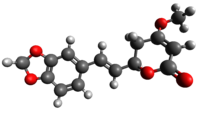Methysticin

| |

| |
| Names | |
|---|---|
| IUPAC name
(2R)-2-[(E)-2-(1,3-Benzodioxol-5-yl)ethenyl]-4-methoxy-2,3-dihydropyran-6-one
| |
| Identifiers | |
3D model (JSmol)
|
|
| ChemSpider | |
| KEGG | |
PubChem <abbr title="<nowiki>Compound ID</nowiki>">CID
|
|
CompTox Dashboard (<abbr title="<nowiki>U.S. Environmental Protection Agency</nowiki>">EPA)
|
|
| |
| |
| Properties | |
| C15H14O5 | |
| Molar mass | 274.272 g·mol−1 |
Except where otherwise noted, data are given for materials in their standard state (at 25 °C [77 °F], 100 kPa). | |
| Infobox references | |
Methysticin là một trong sáu loại kavalactone chính được tìm thấy trong cây kava.[1] Nghiên cứu cho thấy rằng methysticin và hợp chất dihydromethysticin có tác dụng gây cảm ứng CYP1A1 có thể gây ra độc tính của chúng.[2]
Độc tính
[sửa | sửa mã nguồn]Methysticin tạo ra chức năng của enzyme gan CYP1A1, một loại enzyme liên quan đến độc tính của benzo [ a ] pyrene thành (+) - benzo [ <i id="mwEA">a</i> ] pyrene-7,8-dihydrodiol-9,10-epoxide, một trong những loại cao nhất chất gây ung thư được biết đến. Tài sản này được chia sẻ bởi các hợp chất dihdromethysticin có liên quan, cả hai đều xảy ra với số lượng đáng kể trong Piper methysticum.[2][3][4]
Tham khảo
[sửa | sửa mã nguồn]- ^ Malani, Joji (ngày 3 tháng 12 năm 2002). “Evaluation of the effects of Kava on the Liver” (PDF). Fiji School of Medicine. Bản gốc (PDF) lưu trữ ngày 20 tháng 3 năm 2009. Truy cập ngày 4 tháng 9 năm 2009.
- ^ a b Li Y, Mei H, Wu Q, Zhang S, Fang JL, Shi L, Guo L (tháng 12 năm 2011). “Methysticin and 7,8-dihydromethysticin are two major kavalactones in kava extract to induce CYP1A1”. Toxicological Sciences. 124 (2): 388–99. doi:10.1093/toxsci/kfr235. PMC 5736320. PMID 21908763.
- ^ Beresford, AP (1993). “CYP1A1: friend or foe?”. Drug Metab Rev. 25 (4): 503–17. doi:10.3109/03602539308993984. PMID 8313840.
- ^ Uno, S; Dalton TP; Durkenne S; Curran CP (2004). “Oral exposure to benzo[a]pyrene in the mouse: detoxication by inducible cytochrome P450 is more important than metabolic activation”. Molecular Pharmacology. 65 (5): 1225–37. doi:10.1124/mol.65.5.1225. PMID 15102951.